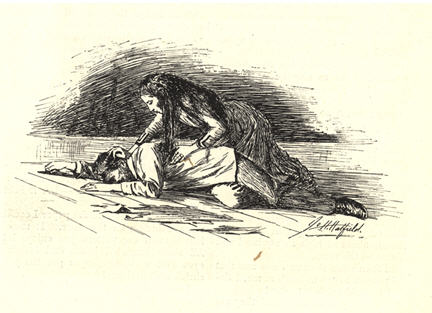NLM Launches New Exhibition, "The Literature of Prescription: Charlotte Perkins Gilman and The Yellow Wall-Paper"
Lecture, Q and A Sessions with the Curator and a Traveling Version Will Help Spread Word of this Gripping Examination of Women's Roles and the Relationship between Science and Society
The National Library of Medicine yesterday unveiled "The Literature of Prescription: Charlotte Perkins Gilman and The Yellow Wall-Paper," a banner exhibition which will be on display in the lobby of the National Library of Medicine (Building 38, first floor) through Saturday, September 26. The Library is open 8:30 AM to 5:00 PM weekdays (except Federal holidays) and 8:30 AM to 2:00 PM Saturdays.
The exhibition examines the relationship between science and society. In the late 19th century, when women were challenging traditional ideas about gender that excluded them from political and intellectual life, medical and scientific experts drew on notions of female weakness to justify inequality between the sexes. Artist and writer Charlotte Perkins Gilman, who was discouraged from pursuing a career to preserve her health, rejected these ideas in a terrifying short story titled "The Yellow Wall-Paper." The famous tale served as an indictment of the medical profession and the social conventions restricting women's professional and creative opportunities.
"This exhibition is opening at a time of renewed interest in Gilman's life and 'The Yellow Wall-Paper,'" observed curator Manon Parry, of NLM's History of Medicine Division. "Her classic tale of the treatment of depression is not only a shocking horror story, but a powerful critique of the medical profession and one of the founding texts of American feminism."
This exhibition describes Gilman's life and career, her experience of depression, the medical advice of Dr. S. Weir Mitchell, and the writing and publication of "The Yellow Wall-Paper." The six-banner traveling version is accompanied by an online exhibition which includes additional primary source texts, educational resources for high school and undergraduate students, and references for further research. You can visit the exhibition Web site at http://www.nlm.nih.gov/theliteratureofprescription .
- In conjunction with the exhibition's launch, the History of Medicine Division seminar series will feature a presentation by historian Helen Horowitz , author of a forthcoming book on Gilman and Dr. Mitchell, and developer of the higher education module available on the exhibition Web site, which will launch the week of October 1st. The higher education module is a new element for college professors and students. Using the exhibition as a resource, scholars develop six hours of class materials including supplemental readings, discussion points, and other content.
- As part of a collaboration with the Schlesinger Library, Cambridge Massachusetts, the exhibition Web site will also feature digitized images and manuscript pages from the papers of Charlotte Perkins Gilman.
- The Exhibition Program will also be offering special Question and Answer sessions with the exhibition curator, from noon to 1 PM Wednesday, September 9th, and Wednesday, September 23rd. To schedule a tour at another time during the exhibition's run, please contact Erika Mills, Exhibition Coordinator, at: 301.594.1947 or NLMExhibition@mail.nih.gov
- Beginning October 4th, two copies of the show will be on display in libraries across America. Please consult the Traveling Exhibitions Web site for the tour schedule, or to apply to be a host institution. As with all NLM traveling exhibitions, this show is available free of charge with borrowing institutions paying incoming shipping only (about $200-300).

Charlotte Perkins Gilman writing at her desk, ca.
1916-1922.
Courtesy Schlesinger Library, Radcliffe Institute, Harvard
University

Illustration from "The Yellow Wall-Paper," which shows the
narrator with her husband, who has fainted after finding her in
deep distress,
The New England Magazine, January 1892. Courtesy National Library
of Medicine
###
